Cpd20-Benzimidazol-Oxadiazol
eqBChE IC50 = 0.15 nM, hBChE IC50 = 45.2 nM
General
Type : Benzimidazole,Oxadiazol,Cyanide,Carboxamide
Chemical_Nomenclature : 2-[2-(4-amino-1,2,5-oxadiazol-3-yl)benzimidazol-1-yl]-N-(3-bromo-5-cyanophenyl)acetamide
Canonical SMILES : C1=CC=C2C(=C1)N=C(N2CC(=O)NC3=CC(=CC(=C3)C#N)Br)C4=NON=C4N
InChI : InChI=1S\/C18H12BrN7O2\/c19-11-5-10(8-20)6-12(7-11)22-15(27)9-26-14-4-2-1-3-13(14)23-18(26)16-17(21)25-28-24-16\/h1-7H,9H2,(H2,21,25)(H,22,27)
InChIKey : IFFSXCHPOGNWKL-UHFFFAOYSA-N
Other name(s) : BChE-IN-8,HY-147859,CS-0529688,Compound 20
MW : 438.2
Formula : C18H12BrN7O2
CAS_number :
PubChem : 156768768
UniChem : IFFSXCHPOGNWKL-UHFFFAOYSA-N
IUPHAR :
Wikipedia :

Target
Families : Cpd20-Benzimidazol-Oxadiazol ligand of proteins in family: BCHE
Stucture :
Protein : human-BCHE
References (1)
| Title : A highly effective and stable butyrylcholinesterase inhibitor with multi-faceted neuroprotection and cognition improvement - Li_2022_Eur.J.Med.Chem_239_114510 |
| Author(s) : Li Q , Xiong B , Wang Y , Lyu W , Xing S , Chen Y , Liao Q , He S , Feng F , Liu W , Sun H |
| Ref : Eur Journal of Medicinal Chemistry , 239 :114510 , 2022 |
| Abstract : Li_2022_Eur.J.Med.Chem_239_114510 |
| ESTHER : Li_2022_Eur.J.Med.Chem_239_114510 |
| PubMedSearch : Li_2022_Eur.J.Med.Chem_239_114510 |
| PubMedID: 35728508 |